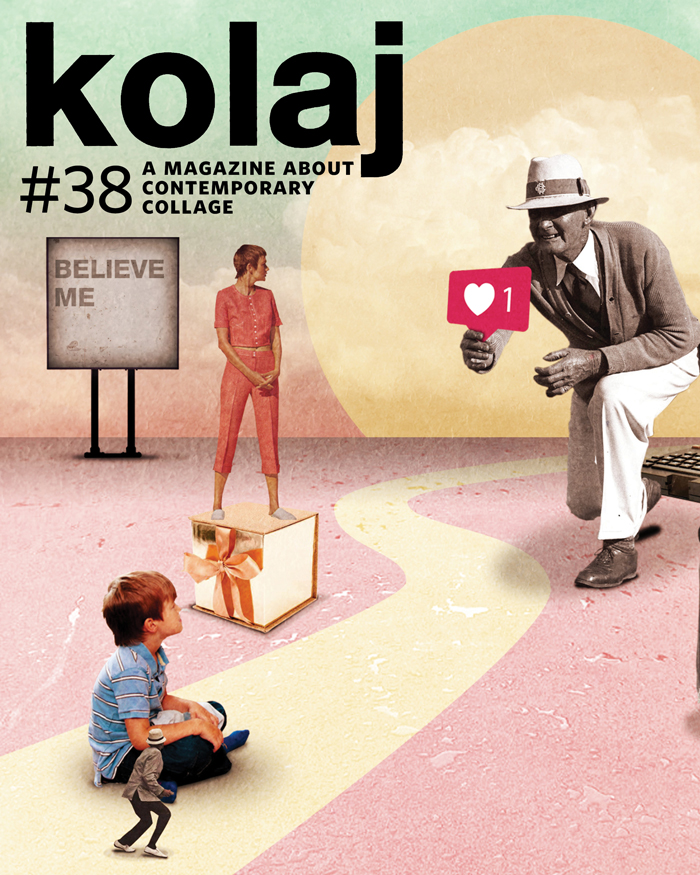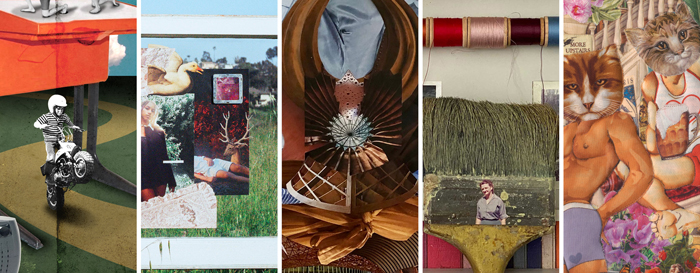
Kolaj is a quarterly, printed, 10″x8″ art magazine
featuring reviews and surveys of contemporary collage. The magazine takes an international perspective on collage as a medium, a genre, a community, and a 21st century art movement.
SUBSCRIBE OR ORDER A COPY
INSIDE THE ISSUE
In On attrape bien les followers avec des likes (We Are Good at Catching Followers with Likes), this issue’s cover image, a tiny man watches a boy who watches a man holding a sign with an Instagram like on it. Two women gaze from a distance. A sign in the back says, “Believe Me”. The collage is a commentary on how social media fights for our attention, devotion, and patronage. A portfolio of SLip‘s collage appears in the issue.
In the issue editorial, Ric Kasini Kadour asks what happens when a work of art becomes detached from the artist, orphaned, unidentified? “Lost Collages” considers those artworks found in attics and thrift shops, divorced from their maker.
In the issue’s round up of News & Notes, we report on Canadian collage artist Rhonda Barrett who opened Cuts & Paste Gallery in Halifax, Nova Scotia in January 2023 and Alicia Saadi‘s billboard installation in New Brunswick, New Jersey. (Saadi recently took part in Kolaj Institute’s Collage as Street Art Residency.)
In “The Abbondanza of Order & Chaos,” Austin, Texas collage artist Lance Letscher shares his idea of good art: “Not to fall into a cliché, but if the work transcends itself, it becomes something bigger or more complex, or more intricate, or more interesting or more curiosity provoking, then it’s more than the sum of its parts: it’s a successful piece of artwork.” Check out or interview with this legend.
“I came to poetry by accident…Which brought me to collage,” writes Kim Triedman in “The Poetics of Collage.” The Massachusetts artist and award-winning author recalls her journey and how poetry and collage mingle in her practice.
Anna Rémuzon explores the subtle, vibrant meeting of Expressionism, Surrealism & Pop Culture in the artwork of Czech artist Tomáš Jetela in “A Rare Hallucination of Reality…Defragmented.” Rémuzon writes, “The characters are fragmented, detached pieces. The faces, the articulated bodies, the accessories—each element has its own origin, its own identity. Jetela ‘glues’ them together in his composition, which creates a new, mutant form of humanity.”
Steven Specht, Ph.D., NCS picks up on Mark Vargo’s article about AI art that appeared in the previous issue in “Art, artifacts, & authenticity: The Problem of De-coupling Process from Product.” He writes, “As a medium, collage lends itself to being mimicked by computer generative algorithms. But I would argue that any generative AI process represents nothing close to the authentic experiences that Kyle [Riecker], or I, or any other collage artist experiences in the process of creating art—even if the process itself is chaotic.”
“The Art of Joy” reports on The University of Colorado Collecting of Frances Joy Bradbury’s COVID-19 project. The artist worked with curator Tyler Alpern, a longtime artist friend, to turn the collection into a book which presents a sample of the collages the artist made every day during the COVID-19 pandemic in 2020 and 2021.
Evelyn Rapin shows us ekphrasis in reverse in “The Secret Life of Plants.” She writes, “Experimentation, chance and accident are huge elements to be embraced in collage assembly.”
In “Southern Axis,” Ric Kasini Kadour writes, “History is always approached on an axis, a through line that guides the narrative. Art History is no different. Traditionally, art history is viewed through an academic lens looking at the evolution of painting and sculpture. A premise of Kolaj Magazine and Institute is that when we turn the axis of art history to collage, the traditional canon opens up to greater diversity.” Kadour reviews the 20th Anniversary Exhibition at the Ogden Museum of Southern Art with an eye to how collage challenges our view of the art history canon.

Artist Portfolios
SLip
Lyon, France
“Unlike a lot of digital collage that seeks to replicate analog aesthetics, SLip’s collages trade on an uncanny valley-like surrealism that is the medium’s signature.”
Barbara Bertino
Frankfurt am Main, Germany
“I feel inspired by everything that has soul and everything that touches my heart: music, a light summer breeze, the stars at night.”
Dariana Dervis
Birmingham, Alabama, USA
“My work grounds me and gives voice to my authentic experiences. I lean on hope as an essential part of navigating the unknowns of this human experience. Without hope, there is no vision.”
Jane Tardo
New Orleans, Louisiana, USA
“There is something wonderfully silly and joyful about Jane Tardo’s ‘Cat Boyfriends and Girlfriends’. The textile collages show maximalist scenes punctuated with hunky and sensual figures, often in various states of undress and unrealistic bulges. Oh, and all the figures have cat heads.”
Hayley Thomas
San Diego, California, USA
“Thomas’s remarkable ability to blend collage, assemblage, in situ installation, and photography in ways that invite us to reconsider the idea of medium as it relates to contemporary art.”
